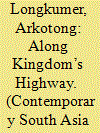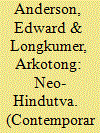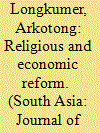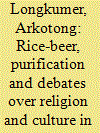|
|
|
Sort Order |
|
|
|
Items / Page
|
|
|
|
|
|
|
| Srl | Item |
| 1 |
ID:
167242


|
|
|
|
|
| Summary/Abstract |
The aim of this paper is to examine the story of the American Baptists and how their mission activities in the Naga Hills District (1871–1955) have impacted upon present day politics in the Indian state of Nagaland. Baptists make up nearly 95% of the current Naga population in Nagaland. The paper will investigate the relationship between the Baptist mission’s philosophy on education, Christian conversion and the subsequent rise of a sense of ‘national community’ amongst the Nagas. Although the primary motivation for the American missionaries was to convert, the British administrators also thought that introducing Christianity would prevent influence on these tribes from Hindu and Muslim groups. Thus began Christianity’s part in a developing framework for resistance in this region, raising significant questions with regard to Christianity’s persistence as a form of political articulation in contemporary Nagaland. This political articulation, I suggest, is related to a greater sense of agency brought about by Christianity and Missionary activities in the fields of education and print. The American Baptist Foreign Mission Society (ABFMS) was at the forefront of these changes.
|
|
|
|
|
|
|
|
|
|
|
|
|
|
|
|
| 2 |
ID:
165237


|
|
|
|
|
| Summary/Abstract |
This article is a preliminary attempt to understand the dynamics of how Patanjali and Baba Ramdev represent ‘Hindu nationalism’, or Hindutva (Hinduness) in Nagaland, India. One can read Baba Ramdev's foray into the region through the promotion of yoga, Ayurveda, and national health, as a form of ‘neo-Hindutva’ that is increasingly diffuse and moves away from a more militant pathway of established Hindutva designs. If one considers the work of Patanjali in Nagaland as an attempt to homogenise and unify a set of practices surrounding food and health practices, then, one can read this as an attempt to assert a singular somatic imagination, increasingly influenced by Hindutva ideas about the body, ‘the health of the nation’, and the promotion of swadeshi (indigenous goods) as patriotic duty. This article highlights the way Ramdev and Patanjali's business empire is trying to move beyond the ‘cow belt’ of north India, comprising mainly of ‘Hindu-Hindi’ into regions that are more diverse linguistically and historically, and culturally viewed as ‘un-Indian’.
|
|
|
|
|
|
|
|
|
|
|
|
|
|
|
|
| 3 |
ID:
165235


|
|
|
|
|
| Summary/Abstract |
The start of this century has seen Hindu nationalism emerge as a more dominant force than ever before. Hindutva is also evolving and shifting in new, surprising, and significant ways, requiring us to reassess and reframe prevailing understandings. This special issue seeks to identify and understand the ways in which Hindu nationalism increasingly permeates into new spaces: organisational, territorial, conceptual, rhetorical. It develops and expands on the idea of ‘neo-Hindutva’: ‘idiosyncratic expressions of Hindu nationalism which operate outside [or on the peripheries] of the institutional and ideological framework of the Sangh Parivar’ [Anderson, Edward. 2015. “‘Neo-Hindutva’: The Asia House M.F. Husain Campaign and the Mainstreaming of Hindu Nationalist Rhetoric in Britain.” Contemporary South Asia 23 (1): 45–66]. The scope of the articles in the special issue reflects the diversity of contemporary Hindutva, which appears simultaneously brazen but concealed, nebulous and mainstreamed, militant yet normalised. They cover a wide range of topics and places in which we can locate new forms of Hindu nationalism: courts of law, the Northeast, the diaspora, Adivasi communities, and the internet. The special issue also includes an in-depth interview with Christophe Jaffrelot and a postscript by Deepa Reddy. These interventions, we hope, go some way to helping us make sense of contemporary Hindutva.
|
|
|
|
|
|
|
|
|
|
|
|
|
|
|
|
| 4 |
ID:
080584


|
|
|
|
|
| Publication |
2007.
|
| Summary/Abstract |
The Heraka or Gaidinliu Movement among the Zeme Nagas of the North Cachar Hills, Assam, provides a case of millenarian activities based on agrarian reforms. The movement is associated with opposing British rule during the 1930s until India's Independence in 1947 under the guidance of Jadonang and later Gaidinliu. I examine the genesis of the movement which was based on agrarian reform by linking it with the influx of Kuki people and the effect of British land policy on Zeme agricultural practices which caused land shortages and famine. I argue that the Heraka Movement provided an alternative by abolishing certain rituals associated with the agricultural cycle and this in turn changed the social hierarchies and the worldview of the Zeme.
1 This paper was first presented at the 2006 European Conference of Modern South Asian Studies, organised by the European Association for South Asian Studies (EASAS) at Leiden University (Panel 28: Ethnicity and Development: Tribes and Small Peoples of India). I am grateful to Tahulung and Adeule for helping me understand the 'Zeme world'. I am thankful to Paul Streumer, Mohan Gautam, Lindsay Graham, Jeanne Openshaw, Amanda Bowden, Mark Turin, Steven Sutcliffe, Vibha Joshi and Erik de Maaker for their comments and feedback
|
|
|
|
|
|
|
|
|
|
|
|
|
|
|
|
| 5 |
ID:
145464


|
|
|
|
|
| Summary/Abstract |
The aim of this paper is to examine the importance of rice-beer (zao) amongst the Zeme Nagas of Assam. Colonial officials and Christian missionaries brought new ideas into Zeme social and cultural practices, quite different from their own. One way to frame this interaction is to examine the tension between world-views held by indigenous religions and Christianity, and what this tension represents for the Zeme. I aim to demonstrate how the terms ‘religion’ and ‘culture’ can be understood by examining the position of rice-beer in Zeme society. I will show how these debates were influenced by nineteenth-century Victorian interlocutors, and equally how local discourses have appropriated these colonial concepts as a point of leverage for internal social dynamics in contemporary times.
|
|
|
|
|
|
|
|
|
|
|
|
|
|
|
|
|
|
|
|
|